|
Monday, June 11, 2012
Progress Notes
This week we presented for visitors to our museum a new display entitled “Divided Loyalties” provided us by the Missouri State Archives, which is the Archives' newest traveling exhibit. Emphasized in the display are the upheaval and uncertainty that characterized Missouri during the Civil War era. Drawing on more than nine million pages of Civil War related documents and court cases, the exhibit goes beyond the stories of battles and military strategy to consider the charged atmosphere of social conflict that permeated the state for two decades that followed the Kansas Border Wars of the mid 1850’s. The display covers more than 2500 square feet of the lower level of the new addition to our museum. A total of 36 large panels display photos, paintings and narratives in five different groupings.
The Missouri State Archives also provides an audio tour of the panel displays. You can even download the entire 32 min audio tour in one MP3 formatted file (just Right-Click on the link and select "Save Link/Target As..." to save on your computer).
Here is a photo of the first group of panel displays which is located at the north entrance area of the lower level of the new addition (photo 01); and another photo of the last group of panel displays located at the south end of the lower level (photo 02):
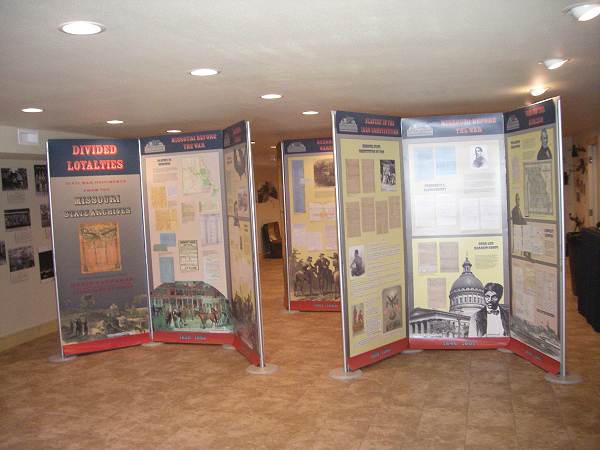
01 Divided Loyalties - North End
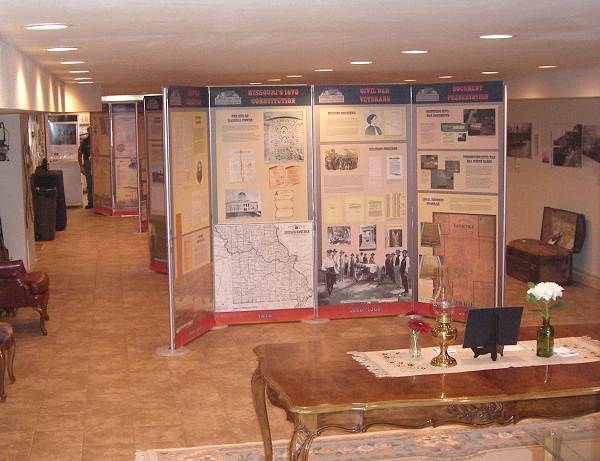
02 Divided Loyalties - South End
Here are a couple of photos of panel groups in the middle of the display (photos 03 and 04):
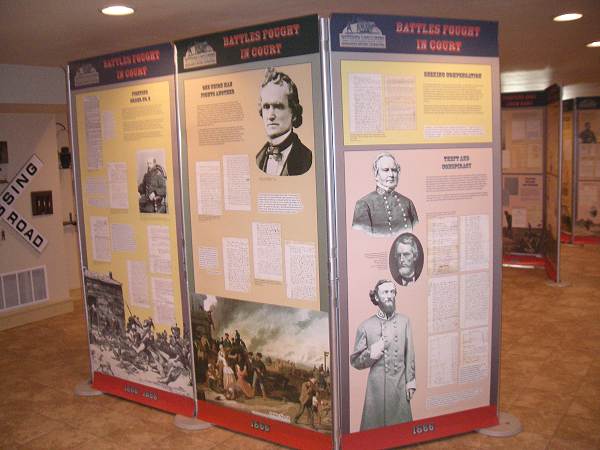
03 Divided Loyalties
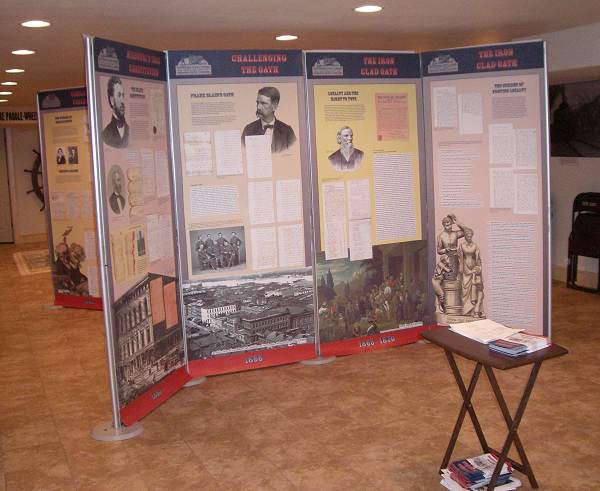
04 Divided Loyalties
The most interesting features of the display are the numerous photos and artists’ paintings of scenes of the many battles and other war related activities. Here are some individual photos of these (photos 05 - 15):
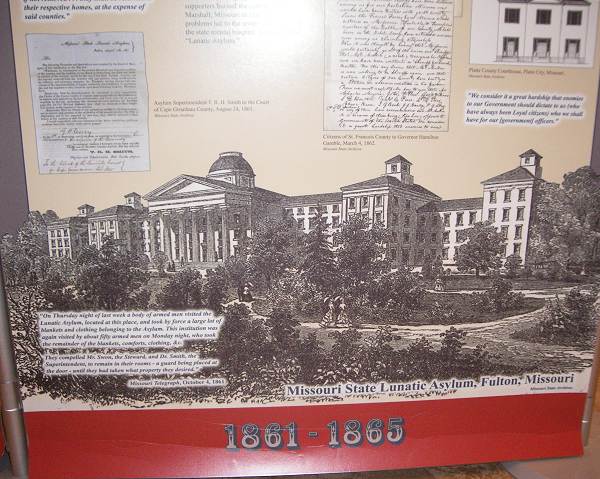
05 Lunatic Asylum - Fulton, MO
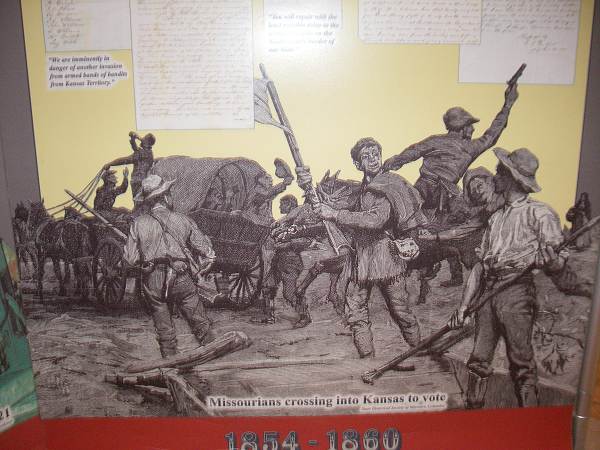
06 Missourians crossing into Kansas to Vote
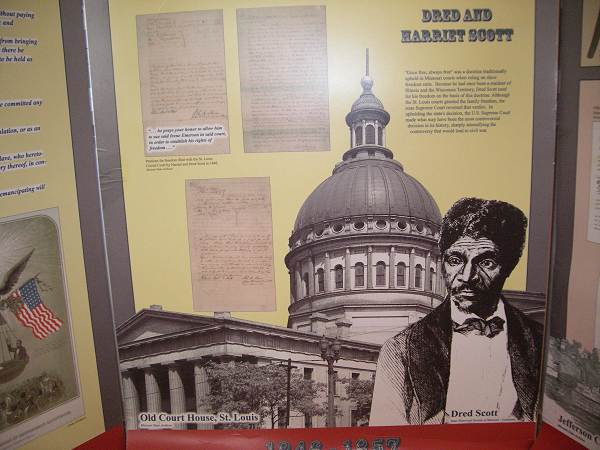
07 Dred Scott
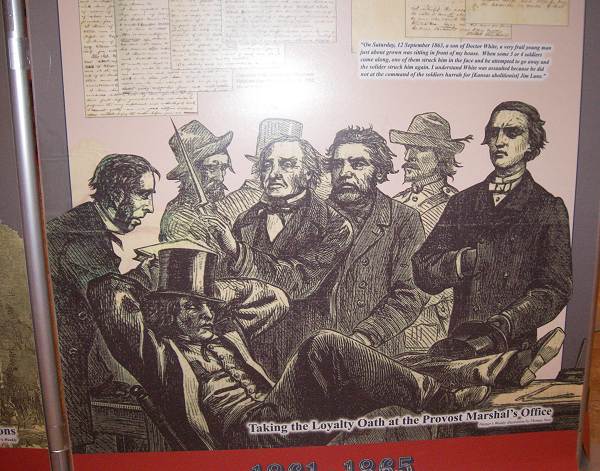
08 Taking the Loyalty Oath

09 Guerillas
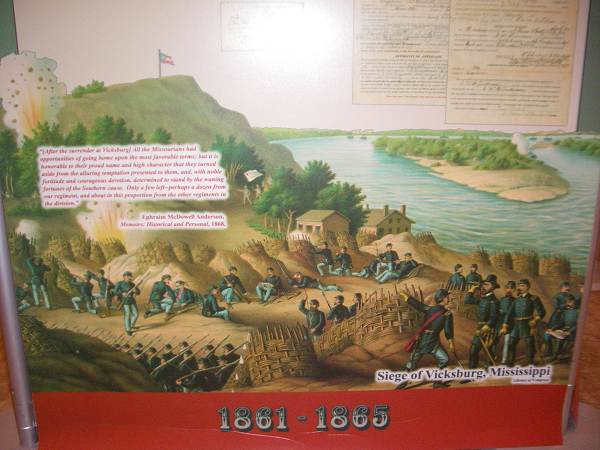
10 Siege of Vicksburg, Mississippi
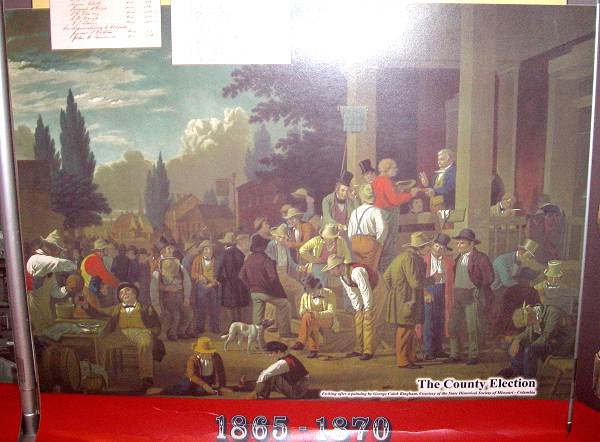
11 County Election
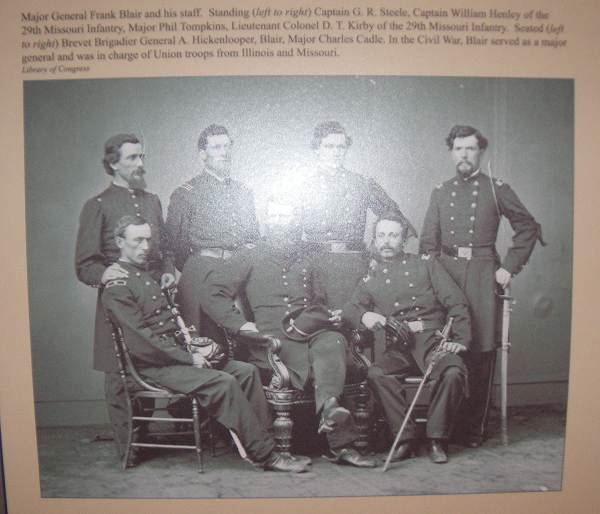
12 Officers of Union Troops
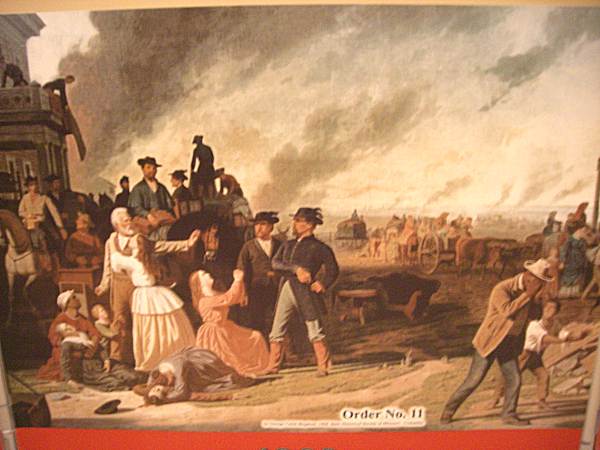
13 Order No. 11 - Civilian Destruction
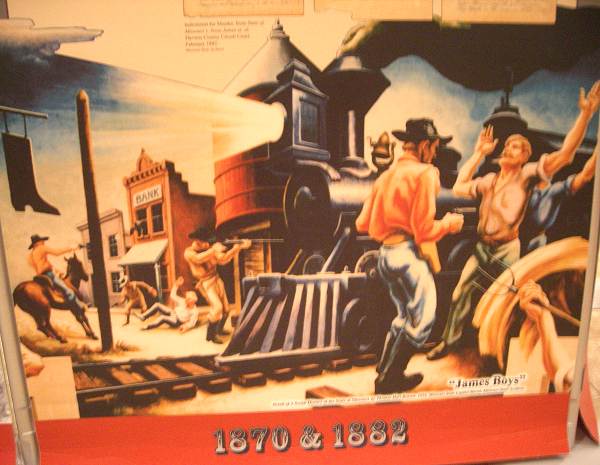
14 James Brothers
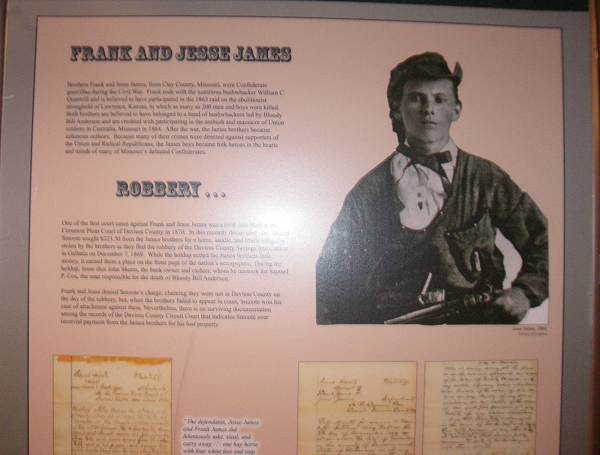
15 Jesse James
The next two photos offer more details about the display as written by the staff of the Missouri State Archives office (photos 16 and 17):
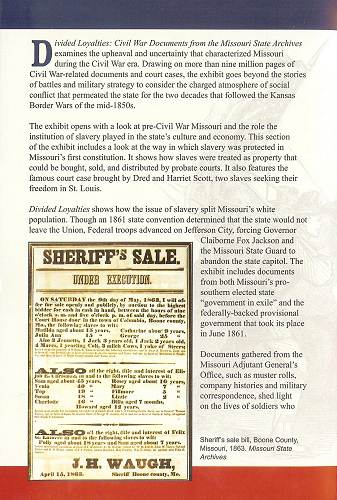
16 Description of Display
Click image for larger view

17 Description of Display
Click image for larger view
The exhibit will be available free without charge until the end of August.
Throughout this sesquicentennial year of acknowledgement and study of the Civil War I have been searching for Miller County residents who served in the Civil War who were in uniform. One good example of those in uniform were the Progress Notes of May 9, 2012 when the six Bear family brothers were featured, all of them in the uniform of the North.
Many times we do not have much history to accompany the photos; however, certainly, we have many more biographies than photos of Civil War veterans since photographers were few and far between during those days.
Recently, I received a photo of a Miller County veteran of the Civil War named William Posten of Eldon, sent by Ed Starling of the state of California (photo 18).
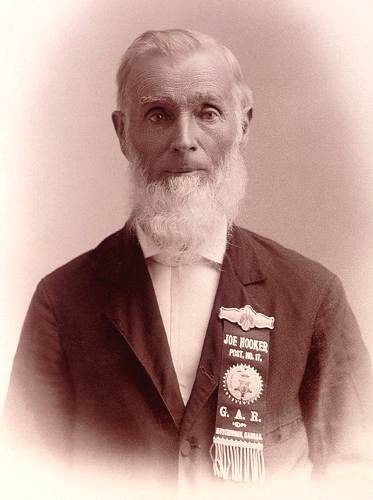
18 William Paxton Posten
Mr. Posten is not in uniform but does have pinned to his coat the ribbon and badge indicating his membership in the Grand Army of the Republic organization, made up originally only of Union supporting soldiers.
Ed also sent a photo of William’s wife, Mary Burlingame Posten (photo 19).
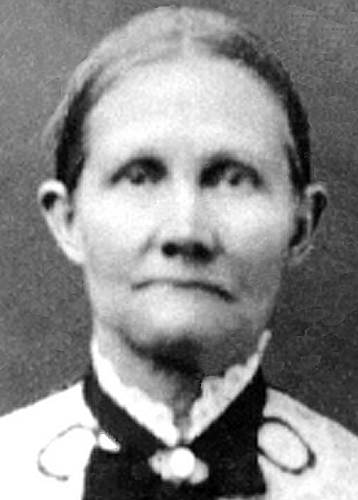
19 Mary M. Burlingame Posten
Ed’s Starling ancestors left Miller County a few generations ago but he has maintained an interest in his Miller County antecedents which included William Posten. Here is the note Ed sent me about what he knows regarding William Posten:
Hi Joe,
I am a descendant of William Posten (2nd great grandfather) and his wife Mary M. Burlingame. William H. Posten (b. December 16, 1877, d. March 14, 1908) is his grandson through son Asa B. "Acy" Posten and wife Mary Melissa Hanby.
Yes, the elder William was a Civil War Veteran, but I don't know much about it. In the photo of him I sent you he is in his old age, wearing a G.A.R ribbon from Joe Hooker Post, No. 17, Hutchinson, Kansas. I don't know much about the G.A.R. Post though and wish I did. I've also attached a few other tidbits, like his marriage documentation from Ohio where he is listed as "Paxton", his land patent, and a tintype of his wife that's a little out of focus. I found her headstone in the Salem Cemetery near Eldon, but did not find his. I live in California so it isn't like I can go back and check repeatedly. When I was there, in the '90s I believe, the place was a mess. I have him passing away near Iberia, but don't have my source handy at the moment. I have made a guess that he was the son of Joseph Posten and Jane..., both from Virginia (or WV), but am not at all sure; the only Postens of that spelling around at the time were found in Morgan/Noble County, Ohio, when William was there. They moved West, I believe, to Iowa. Mary's folks, Burlingames, are the ones that moved to Missouri, and William with them. I have seen the Civil war draft registration of October 1863 in Ancestry.com and found his name, but his age is off by 4 years.
William and Mary's son, William O. Posten, was born September 05, 1851, and died September 26, 1852, both events in Miller County, MO. I have the dates from a borrowed Posten family Bible. I assume the locations from analysis of other documentation locating the family in Miller County around that time. I do not know where he was buried. I have not been able to find the family in Ohio or Missouri in the 1850 census, under Posten, Poston, or Paxton, or associated with the Burlingames under that name. It would be nice to do so.
Sincerely,
Ed Starling
|
Thanks for the information, Ed.
Here is a short family descendency of William Posten and his wife, Mary Burlingame Posten taken from this website.
•Name: William Posten (Paxton)
•Sex: M
•Birth: 7 NOV 1823 in Ohio
•Death: 8 JUN 1898 in Missouri
Marriage 1 Mary M. Burlingame b: 11 NOV 1826 in Morgan County, Ohio
•Married: 19 JAN 1847 in Morgan County, Ohio
Children:
1. M. J. Posten b: 17 OCT 1847 in Miller County, Missouri
2. Emma C. Posten b: 2 OCT 1849 in Miller County, Missouri
3. William O. Posten b: 5 SEP 1851 in Miller County, Missouri
4. S. A. Posten b: 20 SEP 1853 in Miller County, Missouri
5. Asa B. Posten b: 13 OCT 1856 in Miller County, Missouri
6. Mary Blanche Posten b: 20 JUL 1859 in Tuscumbia, Miller County, Missouri
7. Henry H. Posten b: 23 FEB 1862 in Miller County, Missouri
8. Elizabeth R. Posten b: 10 FEB 1865 in Miller County, Missouri
9. Hazen A. S. Posten b: 13 JAN 1870 in Miller County, Missouri
We really don’t know much more about William Posten than what is written above. However, he had a grandson named William H. Posten (son of Asa Posten, son of William), who worked for awhile in Olean, Missouri. A short biography and photo of him was printed in an old newspaper, the Vindicator in 1899, which I am copying from this location on our own website (photo 20):
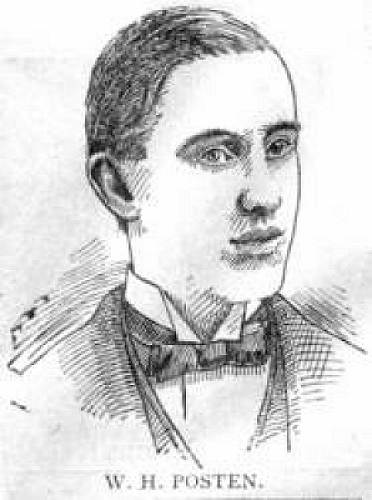
20 William H. Posten - Drawing from Vindicator
W.H. Posten, salesman for Starling, Wieneke & Scott, was born near Barnett, Morgan County, on December 16, 1877. His parents resided on the farm until he reached the age of five then removed to Olean. Mr. Posten received his education in the public schools and enjoys the distinction of “slinging the best fist” of any man in the town of Olean.
His first experience as a salesman was with Mr. Hamlin, who conducted a general store here a few years since. When President McKinley called for volunteers in April, 1898, Will was one of the first to tender his services to the Government and enlisted in Company L., Second Missouri Volunteers. He was given an honorable discharge on March 3rd of this year and after recuperating for a few weeks he accepted a position in the mercantile establishment of Starling, Wieneke & Scott and is there today to await your needs and wants. He is an inveterate reader and can discuss any kind of a topic you may produce for argument and is not particular which side of the question he takes—politics excepted.
I wrote Ed Starling to inquire if he had more information about William H. Posten, grandson of William Posten:
Joe,
These are items relating to William H. "Willie" Posten, grandson of William Posten, and son of Asa B. "Acy" and Mary Melissa (Hanby) Posten. According to Connie Posten Shumaker (his daughter), William H. was a member of "The Governor's Guards" of Company L, Second Missouri Volunteer Infantry, Spanish American War. I have attached a photo of him at Camp George H. Thomas, Chickamauga Park, Walker County, Georgia, dated 1898 (photo 21).
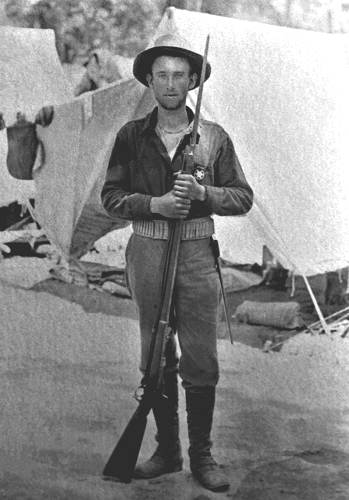
21 William H. Posten in uniform Spanish American War
I also attached a wedding photo of him with wife Anna E. Garrison (photo 22).
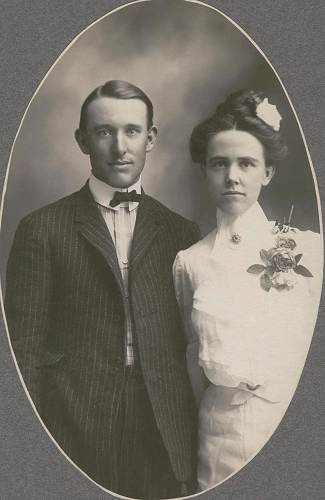
22 William Posten and Anna Garrison - Wedding Photo
There is also a photo attached of him in 1892 as a young man that I record as being from Hutchinson, Kansas (photo 23).
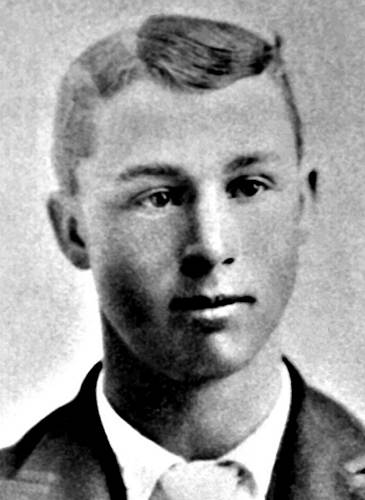
23 William H. Posten
William was buried in the Eldon cemetery. After William died, Anna moved to Colorado, married and divorced a man named Blair.
|
So that is the story of the Miller County Posten family and their contribution of family members to the Civil War and the Spanish American War. There may have been members of the Posten family who served in the armed services during the wars of the 20th century but I don’t have information about the family after the late 19th and early 20th century.
Do you know where was located Miller County’s first bank? It was in the north part of the county at Olean. An interesting history of this bank was published in the sesquicentennial edition of the Eldon Advertiser in 1976 which I happened upon recently from our files. I thought some might be interested in reading that article:
Olean Had First Bank In County
Eldon Advertiser
Bicentennial Salute 1976
This line drawing of the south side of Olean’s business district is by Norman L. Reese, Itasca, Illinois, a commercial artist whose wife is the former Maude Rose Allee of Olean (photo 24).

24 Olean Main Street
It is from a photo taken in 1963 before the former brick bank building in the foreground which housed the county’s first bank was destroyed by fire two years ago.
Note: Here is a photo of the bank (photo 25):
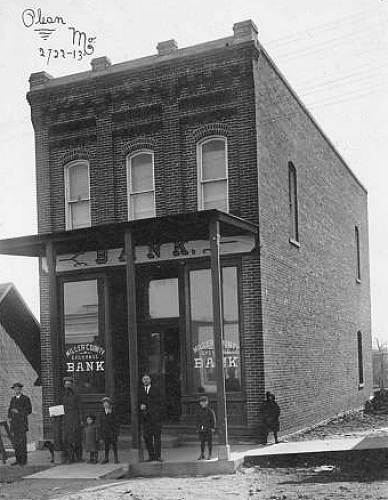
25 Miller County Exchange Bank in Olean
The Allee family was among the founding fathers of the community later to be known as Olean, which sprang up around the station on the newly arrived Missouri Pacific Railroad in the early 1880’s. Both Mrs. Reese’s father, the late Priest Allee, and her grandfather, the late Dr. William S. Allee, were associated with this bank, the Miller County Exchange Bank. Dr. Allee, who practiced medicine in Olean for 36 years until his death in 1916, helped organize the bank which opened for business in 1889, and was elected its president in 1890, serving for 24 years (photo 26).
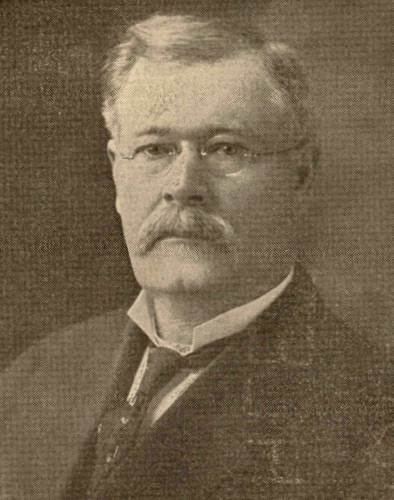
26 Dr. W.S. Allee
His son, Priest, was associated with the bank from 1912 until 1937 when it was sold to the Bank of Eldon.
Dr. Allee, a native of Moniteau County where his family had resided since 1862, began his practice in California, Missouri, and later located in High Point. In the fall of 1881, with the arrival of the Missouri Pacific, he moved his home and practice to Olean. There he built the first residence in the town, a home that remained in the family until Mrs. Priest Allee moved to Itasca to make her home with the Reeses following the death of her husband in February, 1973.
On the north sided of the business district, but not visible in this drawing, is another building erected in 1882 by Dr. Alee, who also served as a state Senator and president of the Missouri State Medical Association. It was here that he and Robert G. Atkin opened a drugstore in June, 1883.
In the early days of the town, the business buildings shown here, from the left, were the bank with lodge hall on the second floor, the barbershop, restaurant with living quarters above, warehouse for the hardware store across the street, post office, and town hall (see photo 24 above). Visible in the next block up the hill is the former MFA Exchange building which is believed to have housed a doctor’s office earlier, and the hotel.
Three buildings that have served as Olean post offices are shown. The bank building later became the post office when Priest Allee became postmaster in 1940, serving until his retirement in 1958. Next to it in the one story former barbershop is the present post office with Mrs. Venita Enowski as postmaster. Next to the town hall is the building built by Postmaster Walter Roark for the pot office in early days. The sign, designating it as the U.S. post office, is still faintly visible.
Note: You can read the complete biography of William S. Allee at this previous Progress Notes.
Now that you know about Miller County’s first bank, do you know where the first Miller County Post Office was located? It was in Tuscumbia as told by Lawrence Wright (photo 27) in the following narrative which offers some interesting early history about the town:

27 Lawrence Alfred Wright
Tuscumbia Post Office Established 1837
James Pryor Harrison First Post Master
Written by L.A. Wright
Miller County Autogram August 19, 1937
Tuscumbia! The name brings forth meditations of a century ago; back in the “dim ages” of Miller County history, and as to how and when Tuscumbia received its name.
A biographer in 1889, in writing a sketch of Tuscumbia, described its location and setting in these words:
“If not an ancient capital, Tuscumbia can boast of a considerable age, as the oldest laid out town in Miller County, and her fortress like courthouse, overlooking from its heights the swift Osage and the tumbling bluffs around seems to rest confident in its sway over both sides of the river for many more half centuries to come, whether the town continues to rest about the foot of its bluff or not.”
How many times have you heard the question, “Where did Tuscumbia get its name? Who named it? What does the name mean or signify?
After an investigation extending over several months of 1928, the writer has brought forth a story which should be of interest to everyone who has visited Tuscumbia, and who knows its age and the heretofore scanty available data concerning its establishment.
Even our oldest settlers would balk when it came to supplying any real facts.
Tuscumbia was an Indian trading point in the very early years of 1800; bold explorers pushing their canoes up the Osage River from the Missouri, and trading here with the Indians. The oldest settlers do remember being told by the first pioneers of the Indian camp on the banks of the Osage at the foot of the bluff, and near the big spring.
Some years after this, in the 1830’s, two bachelors…J.P. and J.B. Harrison…built a log trading post on the left bank of the slough, now known as the “Shut In branch,” then near the spring and in a dense forest; for even before this a white man, in conversation with an Indian, had been assured by the Indian that should he ever build at this point he ought to have his sills above a certain mark on the bluff side, and overflows would never touch them.
Later, came Daniel Cummings, who did as directed when he built (in 1844) the big building which stood, for more than a half century, between the bluff and the spring.
James Pryor Harrison entered the land where Tuscumbia now stands in the year 1836, and he and Mr. Cummings later engaged in the trading and merchandising business in the building which Mr. Cummngs built. In 1838, Tuscumbia had another business, a saloon opened by Jesse Kendrick. Later Mr. Cummings built a hotel and Emanuel Godlove was host (photo 28).

28 Emanuel Godlove
Before the Civil War the town continued to grow under the hill in the quaint, irregular style, when everything came to a stand still. After the war, buildings began to be erected more on the hill.
It was in 1837 that Tuscumbia, on February 6th, that Miller County became a separate county from the territory once being a part of Cole. It was largely through the influence of William Miller that the change was made, and the first terms of court were held at the house of William Miller (photo 29).
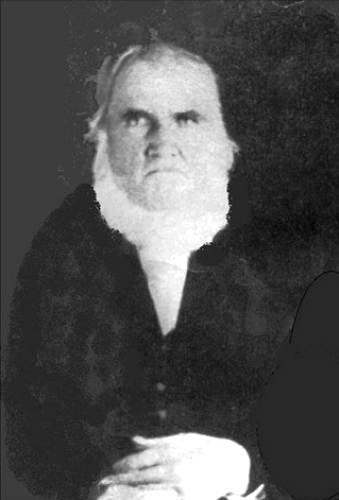
29 William Miller
Mr. Miller lived in a log house on the hill at the mouth of the Saline Creek, where C.P. Tellman now lives (photo 30).
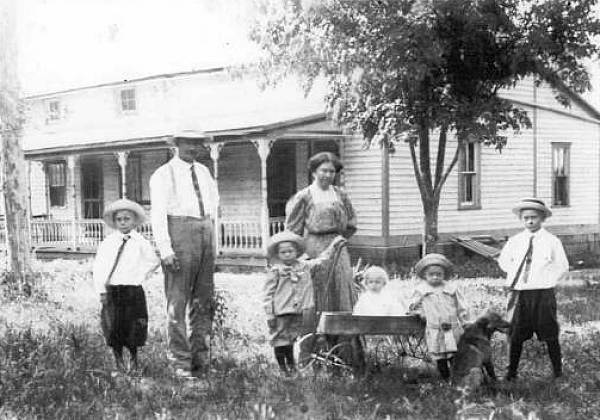
30 Charles Tellman and Family
Then a commission composed of David Fulbright of Pulaski County, Zacheus German of Morgan County and John Hensley of Cole County was appointed to select a permanent seat of government for Miller County.
The second term of the court was held in the store of J.P. Harrison and brother at what is now Tuscumbia, which was the site chosen by the commissioners, on land donated by J.P. Harrison. The town was ordered named and was surveyed out by Marquis Calmes, and was named, it appears, in honor of Tuscumbia, Alabama, the only other town in the United States of this name.
That the name Tuscumbia was familiar to our early settlers was probably due to the fact that Tuscumbia, Alabama, is located on a river, and early settlers at Tuscumbia, Missouri, probably propelled their canoes from Tuscumbia, Alabama, down the Tennessee River and thence up the Mississippi, Missouri and Osage to arrive here.
In order to determine what the name Tuscumbia meant, I entered into correspondence with Mr. F.R. King of Tuscumbia, Alabama, a man well along in years, who has the reputation of being one of the best posted men in Alabama in early history of that section. Mr. King has our thanks for furnishing the following very interesting story, and no doubt, our early settlers who named Tuscumbia, Missouri, knew something of the sentimental side of naming Tuscumbia, Alabama, and so named Tuscumbia, Missouri, in honor of the Alabama town.
“In 1817, at the village of Reyoldsburg, Tennessee, occurred an awful tragedy. The Creek Indians burned and sacked the town; and few there were who escaped death; but among those who did were Michael Dickson and his wife and four sons. Mr. Dickson’s father in law, an old man, viewing the situation as an ugly one, hastily summoned his son and family and suggested that they at once leave the place.
“All agreed, and a keel boat was quickly gotten and all that they possessed was loaded into it and after all had gotten into the boat, they started up the Tennessee River, to a country about which little was known at that time. For days they labored…until time went into weeks, but they were at last pleased with the surroundings, and pushed for the shore which was at the mouth of Spring Creek, and two miles from the “big spring,” (now Tuscumbia), which flows a quarter of a mile and empties into Spring Creek, one and three fourths miles from the Tennessee River.
“It was night when they steered to the head of the “big spring.”
Here they spent the night, and next morning old man Dixon met and smoked the “peace pipe” with the Cherokee Chief named… ‘Tuscumbia.’
“The Dicksons always said that the old chief was a good, gentle man, but like most of his tribe, was not a good financier. Mr. Dickson drove a trade (“a bargain”) with the Chief by which he acquired all the land from the mountain south of the ‘big spring’ two miles, to the Tennessee River. This tract, with a four mile frontage, was even in those early days, a vast amount of land. Mr. Dickson gave Tuscumbia five dollars in silver and two pole axes, and often said it was the best trade he ever made.”
“In 1818 there came into the Dickson family a little girl, whom the parents named Annie. She was the first white child born at the ‘Big Spring,’ Alabama.”
“In 1820 a few white settlers had drifted in, and they began to feel the need of a name for the new white settlement whereby they could have a post office, it being inconvenient to travel thirty six miles back and forth to Russellville to get a letter or to post ones. It was suggested that an election be held, and the name of little Annie Dickson and that of Tuscumbia be voted on, and that the one receiving the majority of the votes would have the honor of having the town named for him or her. Chief Tuscumbia won by one vote and he was so delighted by being thus honored that he had a pair of beaded buck skin slippers made for little Annie.”
Mr. King here noted the similarity of the two towns, Tuscumbia, Alabama, and Tuscumbia, Missouri, both at a big spring and near the river. However, the Alabama spring is much larger than the Missouri spring, the Alabama spring flowing 17,724 cubic feet of water per minute.
After having the above correspondence with Mr. King, he was requested to secure, if possible, the meaning of the word Tuscumbia. He supplied the following information relative to the same:
“The small stream upon which a village of Cherokee Indians and a few French Traders was destroyed by General John Robertson, from or near Nashville, Tennessee, in about the year 1790. The site of this Indian village is near or a part of the city of Tuscumbia (Alabama). The village was called ‘Occocoposa,’ or more correctly, ‘OkoKaposa,’ meaning in the Chickasaw-Choctaw dialect, ‘cold water. ‘On June 14, 1821, it was changed to ‘Big Spring,’ and then to Tuscumbia on December 3, 1822. Tuscumbia is derived from the Chicakasaw word, “The warrior who kills.”
In order to determine the date on which Tuscumbia, Missouri, became a post office, a letter was addressed to the Post Office Department at Washington, D.C. This letter was answered by Mr. John H. Bartlett, First Assistant Postmaster General, under date of August 19, 1927, which is as follows:
“In reply to your inquiry of the 10th instant, you are informed that the post office at Tuscumbia, Missouri, was established December 21, 1837, with James P. Harrison as postmaster.”
It is then established that Tuscumbia, Missouri, was named about 15 years after Tuscumbia, Alabama, and that the name originated in Alabama, from the name of the Indian dialect meant, “The warrior who kills.”
This name was chosen for Tuscumbia, Missouri, by those who were instrumental in having it become a post office, possibly the Harrison brothers, Jesse Kendrick and Marquis Calmes, the last mentioned being the surveyor who laid out the town.
That’s all for this week.
 Joe Pryor
Previous article links are in a dropdown menu at the top of all of the pages.
|

